Editor’s Note: Nancy Novick reviewed “The Outdoor Museum”, by Margery and Sheldon Harnick, and also got a chance to meet and interview them. Both the review and the Q&A are below.
By Nancy Novick
Spend a little time with Upper West Siders, Margery and Sheldon Harnick and you soon get a glimpse of why this couple has collaborated so successfully on a lovely new book called The Outdoor Museum (not your usual images of New York). More than a photography book (although the 90-some images taken by Mrs. Harnick are arresting on their own) The Outdoor Museum also includes eleven poems by Mr. Harnick, the award-winning lyricist whose body of work includes Fiddler on the Roof, Fiorello, and She Loves Me among many others. The marriage of words and images in their new book reflect a sharp eye for beauty in the ordinary and unexpected, that the couple shares.
While Mrs. Harnick, who is known professionally in the theater as Margery Gray, has photographed subjects all around Manhattan, many images in the book were taken on the Upper West Side, with some more quickly recognizable than others. The photo of the man admiring the rounded figure of a Botero nude in the atrium of the Time-Warner building is an example. As is the angel that sits at the top of Bethesda fountain in Central Park photographed head-on and from behind, dark against a winter-blue sky. The images are preceded by the poem construction in blue, white & black, in which Mr. Harnick plays with the ideas of colors and their associations (photos in this review are from the book).
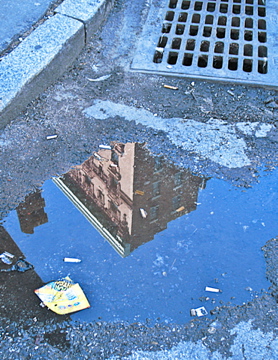 Mrs. Harnick’s fascination with reflected images is on display with photographs that show both modern skyscrapers and local apartment houses mirrored in the surfaces of puddles, cars, and other buildings. (Readers who live nearby might want to see how many they can recognize.) With their rippling lines and blurred fragmented quality, the images of buildings reflected in glass and steel towers, inspired Mr. Harnick to write Debussy in New York, his vision of what the composer’s work would have looked like had he been an architect.
Mrs. Harnick’s fascination with reflected images is on display with photographs that show both modern skyscrapers and local apartment houses mirrored in the surfaces of puddles, cars, and other buildings. (Readers who live nearby might want to see how many they can recognize.) With their rippling lines and blurred fragmented quality, the images of buildings reflected in glass and steel towers, inspired Mr. Harnick to write Debussy in New York, his vision of what the composer’s work would have looked like had he been an architect.
Along with novel views and verbal portraits of New York City architecture, shop windows, and public art, Mrs. Harnick turns her lens to the “temporary exhibits”, the forgotten suffering of homeless people on the street; the moment of grace in the subway, where a musician has left his cello leaning against a column. Mr. Harnick’s accompanying poems range from the poignant Questions, which looks for ways of knowing the anonymous figures in his wife’s photos to the funny spot-on Subway Haikus. One of my favorites reads:
If your train pulls in
just as you arrive, this does
not mean God loves you.
The romantic and playful poet is in evidence in Swonnet, Mr. Harnick’s 14-line rhyming poem that compares the swans in Mrs. Harnick’s gorgeous photos to sirens—in both cases, proximity to beauty has its hazards.
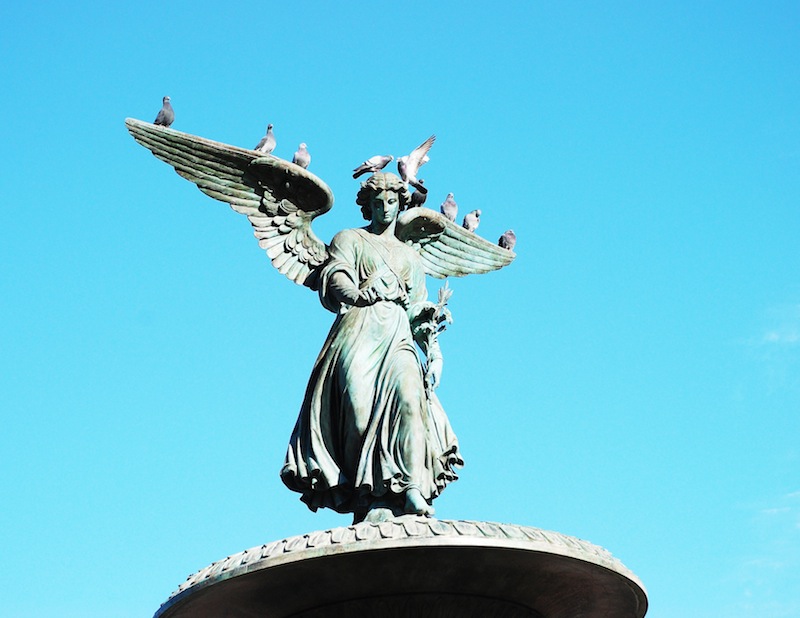 In the final section of the book, the Harnicks contemplate the nature of landmarks. A photo that stands out among the rest, not so much for its beauty as for its glimpse of human nature, focuses on a family of tourists taking pictures on Fifth Avenue, illustrating that common impulse to capture some essential New York scene. Mr. Harnick’s accompanying poem reads in part, “…show me some far-famed/photogenic icon/and I’ll show you a tourist/fiddling with his Nikon /(or Kodak or Lumix or Sony)/ hoping the light is right/gamely trying to Canonize/this semi-sacred site.”
In the final section of the book, the Harnicks contemplate the nature of landmarks. A photo that stands out among the rest, not so much for its beauty as for its glimpse of human nature, focuses on a family of tourists taking pictures on Fifth Avenue, illustrating that common impulse to capture some essential New York scene. Mr. Harnick’s accompanying poem reads in part, “…show me some far-famed/photogenic icon/and I’ll show you a tourist/fiddling with his Nikon /(or Kodak or Lumix or Sony)/ hoping the light is right/gamely trying to Canonize/this semi-sacred site.”
Mr. Harnick understands the impulse, but also pays tribute to the great photographers who have shown us New York City from another point of view—Alfred Eisenstaedt, Ruth Orkin, Helen Levitt, Walker Evans—and to his wife, photographers who “neither glorified nor glamorized New York. Instead they surprised and diverted us delighting us with sights we hadn’t bothered to observe.”
There’s much to appreciate in a quiet reading of The Outdoor Museum. I found a second look at the book, accompanied by the CD of Mr. Harnick reading his poems in a strong and pleasant voice (included with the volume), increased my enjoyment. Readers should also be sure that they don’t overlook the affectionate and entertaining Foreword written by director—and former Upper West Sider—Mike Nichols.
The Outdoor Museum (not your usual images of NEW YORK) is published by Beaufort Books (2012) and sells for $29.95.
Interview:
Married for more than five decades, actress/artist/photographer Margery Gray Harnick and husband Sheldon Harnick, the award-winning lyricist, share an appreciation for the arts, a sense of humor and one another. During a conversation punctuated with laughter, they told me how they came to collaborate on their new book The Outdoor Museum (not your usual images of NEW YORK).
West Side Rag: After working independently on your respective projects, how did this book begin? Did you plan this together from the start?
Sheldon Harnick: No. Several years ago Margie began taking a lot of pictures with her new digital camera and showed me what she’s doing. She had a couple hundred pictures and I was stunned. We called our friend [literary agent] Jane Lahr, and [asked] is there a book in this? She told us there’s still a good market for books in NY. I thought it would help if we divided the photos into categories and I introduced each category with a poem. The photographs inspired all of the poems. For instance when I saw those reflections of buildings in other buildings, they’re so impressionistic. I thought what if Debussy had been an architect? That’s what he would have done. Originally we had more images. We whittled [them] down to the very best. Now there are 11 poems and about 90 photographs.
WSR: Margery, I understand you had already been sculpting and painting for some time, but that photography was a relatively new endeavor.
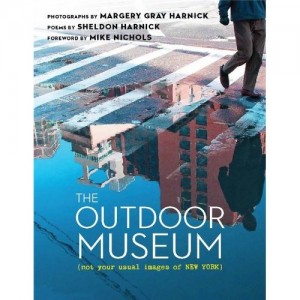 Margery Harnick: I’ve really taken pictures all my life, never thinking I would be a photographer per se, but when I began painting I used my own photographs as a point of departure. But actually the better the camera, the better quality the photographs are. Most of the photos in the book were taken with a Nikon D90. Some were taken with a Panasonic DMC LX2 (also known as the Lumix.)
Margery Harnick: I’ve really taken pictures all my life, never thinking I would be a photographer per se, but when I began painting I used my own photographs as a point of departure. But actually the better the camera, the better quality the photographs are. Most of the photos in the book were taken with a Nikon D90. Some were taken with a Panasonic DMC LX2 (also known as the Lumix.)
SH: You just reminded me about the $1,000 luncheon. Margery’s first husband was a superb photographer. When we were in California some years ago (I had a show in Malibu), we had lunch. I was curious to meet him. So at lunch he pulled out this camera, a Nikon, and he kept taking pictures. Within the next week I had to buy her the same camera. So although he paid for lunch it cost me about $1,000.
WSR: Sheldon, you’ve written in so many forms. Is writing poetry a recent development for you?
SH: I’ve written very few poems. On the few occasions when I’ve been struck by something and I’ve started it as a poem, about half way through I think this would be better as a lyric. But about 25 years ago, I thought here I am a lyricist and I’m working in a field of poetry and I don’t know poetry and I made the resolution to start reading it. I read Shelley first, because he was my namesake, and since then every morning I read about six pages of a poet. I try to do a classic poet and a contemporary poet and through the years I’ve acquainted myself with a lot of different kinds of poetry. When I began to work on the poems for this book I thought it would be fun to use some different forms, the haiku and the sonnet and so forth. If I’d been really adventurous I would have done the triolet, and some wilder forms. I guess because I’d been reading poetry for so long, the nature of poetry was in my head.
WSR: I find your use of haiku to be such a good match, capturing these moments in the subway, e.g. God doesn’t favor you if the subway comes (laughter). It’s a New Yorker’s moment.
SH: I thought I knew what a haiku was but I had to look it up: five syllables, seven syllables, five syllables.
WSR: The idea of New York City as a museum, how did that come about?
SH: When we first looked at the photos [we thought about including], there was a series on working people—photos we didn’t end up using—and there was a picture of a guy up on a scaffold of a building, but it looked like a Mondrian, and I thought [another image] was like a Basquiat and [another] like a Rousseau and it’s like a museum when you walk through the city. Sometimes I just walk around the block and I find just endless things that fascinate me.
MH: You have to be relaxed really [to see the subjects that interest you] and just absorb. Sometimes I think if you’re very worried about something, it’s possible that you’re just so within yourself, you don’t really see. So you just have to relax and walk.
SH: I love my wife very much, but it can be difficult walking with her, because we keep stopping and she says, “wait just a minute” (laughter), and then she’s off taking a picture.
WSR: Margery, does your background in theater inform your photography?
MH: Quite a bit. I started studying ballet when I was four, then singing. I was on a radio show by the time I was seven years old. And when you’re in a rehearsal studio especially in the theater and in dance class, there’s always the mirror. I was fascinated by the changes in the mirror, as opposed to the reality of me standing there. And of course if you’re doing a Broadway show, you learn the whole number, and then suddenly you’re in the theater and there’s no mirror, but you’ve memorized the space between you and the person next to you and in back of you and in front of you. You think about those spaces. I still think about reflections and space in [my] compositions.
WSR: I understand you’ve lived on the Upper West Side a long time.
SH: Yes, since we got married. We raised our children here.
MH: We’ve also seen the neighborhood change since then. I once saw a mugging in the park from our living room window. It’s much safer now.
WSR: It seems as if the UWS has been a center for songwriters and musicians, Leonard Bernstein, Marvin Hamlisch, Adolph Green …
SH: When we moved in our neighbors were Abe Burrows, Dorothy Fields, Beverly Sills, Isaac Stern… It was wonderful.
WSR: What about going out in the neighborhood? Any favorite spots?
MH: Zabar’s
SH: I love the various events at Symphony Space especially the wall to wall [music marathons]. I’ve participated in a number of them [including] a tribute to Sondheim. I got to sing one of the wonderful songs from A Funny Thing Happened on the Way to the Forum, and afterwards Steve [Sondheim] came up to me and said, “You took that awfully slow, I’m surprised you got all the laughs.”
MH: But Sheldon’s a Tony voter; we go to the theater all the time.
WSR: What have you seen that you liked?
SH: Harvey was lovely
MH: Wonderful.
SH: We saw Bring It On. It was terrific, really breathtaking
MH: Amanda Green wrote the lyrics, and she grew up in our building as well—Adolph Green’s daughter.
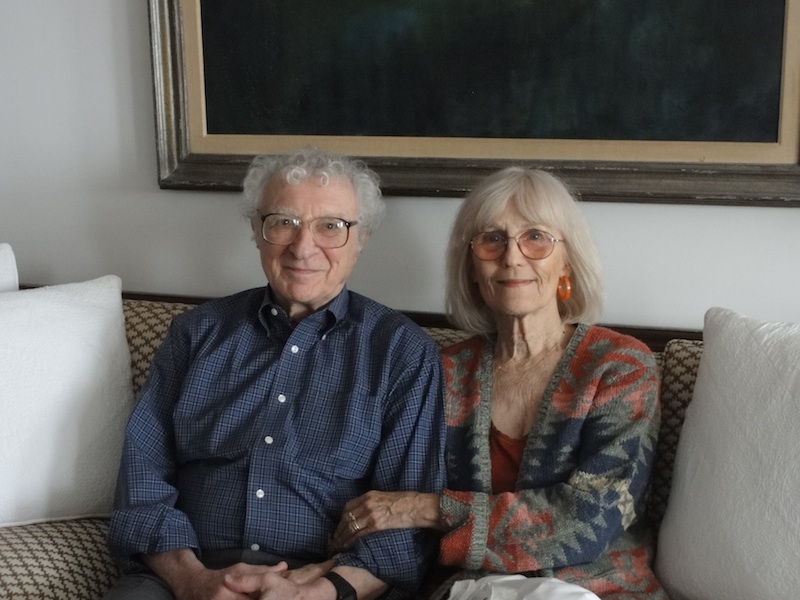 WSR: Recently, the JCC in Manhattan [on Amsterdam Avenue] screened Fiddler on the Roof on their roof. (Mr. Harnick famously wrote the lyrics.) It was so crowded they had to turn people away. Many of us know the wonderful songs, but what do you think makes the story so enduring?
WSR: Recently, the JCC in Manhattan [on Amsterdam Avenue] screened Fiddler on the Roof on their roof. (Mr. Harnick famously wrote the lyrics.) It was so crowded they had to turn people away. Many of us know the wonderful songs, but what do you think makes the story so enduring?
SH: All of us connected with it had different ideas as to why it was so popular. My feeling is that it’s about families and the difficulty of bringing up children who may not have the values you have. They break away and do things that you find difficult to accept, but you love them. The conflict between love and tension is universal. And the other thing is [director] Jerry Robbins’ parents had taken him [when he was six] to a section of Poland where his forefathers came from. He remembered it even at six as a very emotional experience. Then during WW II when he read about the extermination of so many of these shtetls, he resolved to give that culture an additional life on the stage. During rehearsals and afterward he was like a man obsessed. He kept asking questions: why are we doing this? Why are we doing that? It just made for a much better show.
WSR: There’s passion behind it.
SH: Yes. That’s exactly the right word.
WSR: Margery, were you involved at all with Fiddler on the Roof?
MH: I sometimes go to rehearsals of Sheldon’s shows, but I don’t get involved. That’s Sheldon’s work. I have my own. He might ask me questions…
SH: When I forgot something about Judaism I’d ask Margie.
MH: I think it’s better that way.
SH: However, I will say Margie is my sounding board when I’m writing lyrics. I always try new lyrics out on her and if there’s something that she doesn’t understand, or something that seems a little far-fetched, I’ve changed it. I get angry first (both laugh), but then I change it.
WSR: So it’s good to have an editor and a constructive critic in the family?
SH: Absolutely. She’s very smart.
WSR: It sometimes seems as if every other young person you meet in New York City is trying to make it in the arts. Do you have any advice for aspiring photographers, actors or lyricists?
SH: My advice is strictly for theater lyricists, because I’ve never been successful as a pop lyricist. My advice is to see as much musical theater as you can to familiarize yourself with the form and what’s been done. The other thing is to read very widely and really immerse yourself in the world around you, because you never know what you’ll be required to write about and it’s good to have as wide a frame of reference as possible.
MH: Many aspiring young actors ask how do you become a star? How do you get into a show? I say you don’t start out that way. You start out by either being a dancer or an actor or a singer because it’s a calling, you have to do it, you want to do it, you’ll do it at any cost, and you’ll do it for nothing. And if your goal is to be the best at what you’re interested in, you’ll keep doing it, and somehow it will come, there will be an opportunity to do your art in any of those areas. But if just making money or being on television is your goal, to me that’s not realistic at all. That can’t be your goal, because actors don’t work all the time. People in the arts don’t. You have to take other jobs, but you do them so that you have time to do your art, whatever that may be. That would be my advice: do it because you must do it.
WSR: Before we finish, I’d like to know if you plan to collaborate again.
SH: Very much so. We don’t have a concrete idea yet, but we’d very much like to.
MH: Oh yes, and maybe we’d include our son Mathew. He’s a wonderful photographer as well. Our daughter’s a wonderful photographer too, but she’s in California.
SH: Working together is mutually inspiring.
MH: It is.
Photos of the Harnicks by Nancy Novick. She blogs about books, bookstores, and libraries at www.Stacked-NYC.com.



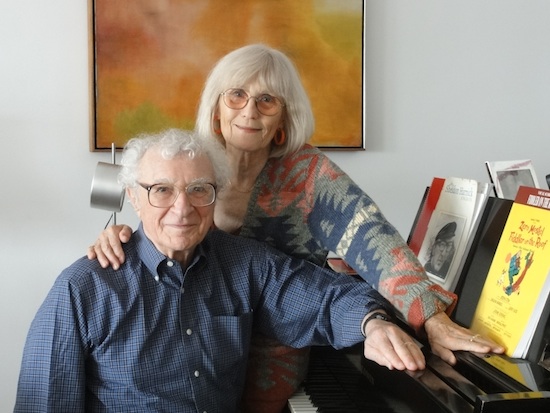



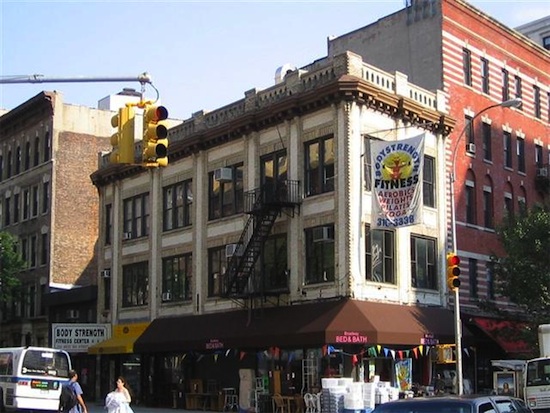
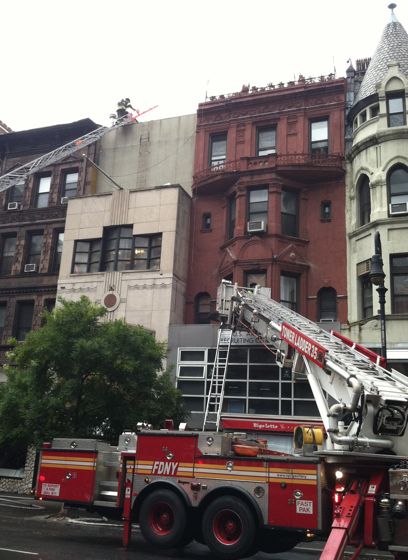

after listening to Sheldon’s public radio interview I google for more info. Happen to see Margery Grey is his 5 decade spouse. Iknew Margery and her parents when living in Sunnyside Ny. We both had young children and did the public school walk together. I was a pleasure to read of her life both personally and professionally.